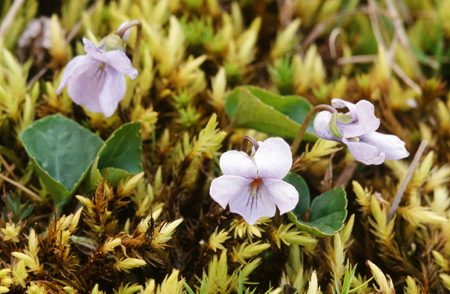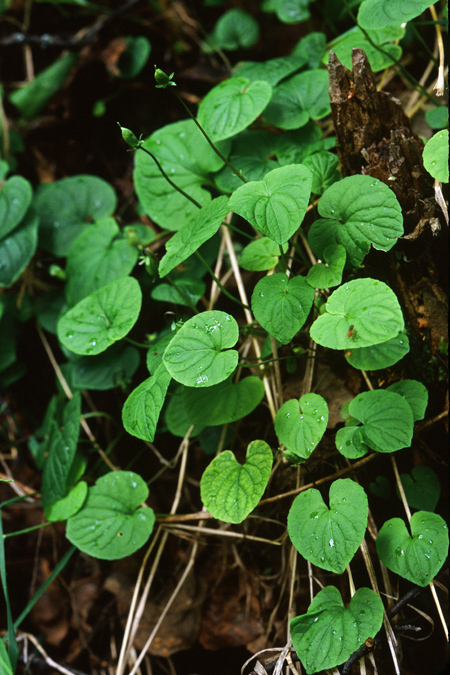Viola suecicaFr.
Common names:
Dwarf Marsh Violet
Synonyms:
Viola suecica Fr., Summa Veg. Scand.: 556. 1849. TYPE: Norway, Finnmark: Tana, Finnmarken vid Polmach [= Polmak], 19 Jul 1802, G. Wahlenberg s.n. (TYPE: UPS-V-1041820; internet image!).
Viola achyrophora Greene, Pittonia 5: 33. 1902. TYPE: USA, [Alaska,] British Behring Sea Commission Collection, St. Paul Island, Jul 1897, J. M. Macoun s.n. (LECTOTYPE, here designated: NDG32053, internet image!).
Viola epipsila Ledeb. subsp. repens W.Becker, Beih. Bot. Centralbl. 34(Abt. 2): 406. 1917; Viola epipsila Ledeb. var. repens (W.Becker) R.J.Little, J. Bot. Res. Inst. Texas 4(1): 225. 2010; Viola repens Turcz. ex Trautv. & C.A.Mey., Fl. Ochot. [Middend. Reise N. & O. Sibir. 1:11]: 18. 1856; Viola repens Turcz., Bull. Soc. Nat. Mosc. 11: 88. 1838 [illegitimate homonym of V. repens Schwein. (1822)]. TYPE: "Originale Turcz. in Herb. Acad. Sci. Petrop.: in saxis humidis ad fl. Schilka a 1833, in humidis pr. Krugloie a. 1834.--Tiling Fl. ajan. nr. 50".
Description:
Acaulescent stoloniferous perennials, colonial from slender creeping rhizome and lateral stolons, leaves, flowers and fruits inserted separately along rhizome near apex, stolons surficial, produced in summer with leaves and cleistogamous flowers and fruits, ≤ 12 cm tall; foliage and peduncles gray-green, glabrous or lower surface of blades with fine hairs along proximal veins; leaves 1–2 and 8–25 mm during chasmogamous flower, spreading; stipules free, green or pink, irregularly glandular-fimbriate; leaf blades undivided, largest ≤ 55 × 41 mm during fruit, round-reniform to reniform, base cordate, margins shallowly crenate, eciliate, apex subobtuse to rounded; chasmogamous peduncle held among or above the leaves; bracts positioned above the middle, often near the apex of the peduncle; chasmogamous flower ≤ 16 mm; calyx glabrous, eciliate; lowest sepals ovate-lanceolate, rounded; auricles short and rounded, not elongating in fruit; corolla pink-purple (rarely whitish), throat greenish-white; spur short-globose, ca. 1.5 mm long, 2–3 × as long as auricles; lateral petals sparsely bearded within with narrowly linear hairs; style and stamen appendages prominently exserted and fully visible in life; cleistogamous flowers produced after chasmogamous, on ascending or erect peduncle shorter than or surpassing petioles; capsule 6–9 mm, green drying tan, unspotted or with fine red spots, glabrous; seeds 1.8–2.0 × 1.0 mm, dark gray to olive-green, blotched; 2n=24.
Similar species:
As members of the Palustres species group, this species and V. palustris share a creeping node-rooting rhizome with lateral stolons, the leaves not forming a discrete rosette but instead inserted individually along the length of the rhizome nearer the apex with flowers and fruits in the leaf axils, broad stipules, reniform leaf blades, and violet corollas. It differs most conspicuously from V. palustris in its fewer and smaller leaves with the lower surface of leaf blades sometimes appressed-hirtellous, bracts positioned above the middle of the peduncle, lateral petals sparsely bearded, and dark gray to olive-green blotched seeds. In cleistogamous fruit, if the rhizome and lateral stolons with leaves inserted separately are disregarded, it may be confused with other Stolonosae. It can be distinguished from V. incognita and V. renifolia by its subentire to crenate leaf blade margins, unspotted cleistogamous capsule, and gray to greenish blotched seeds; and from V. minuscula by the proportionally broader leaf blades often with the lower surface appressed-hirtellous along veins, and dark gray to greenish blotched seeds.
Ecology:
Alpine meadows, marshes, bogs, and shores of lakes and streams.
Distribution:
Interruptedly circumboreal, w. Ontario and n. MI to AK, south to n. MN, w. SD, CO, and WA; boreal e. Asia (no range map yet).
Rarity:
State listed in MI.
Phenology:
Chasmogamous flower June–August, chasmogamous fruit July–August, cleistogamous fruit July–September.
Affinities:
This species belongs to the Acaulescent White Violet lineage, sect. Plagiostigma Godron, subsect. Stolonosae (Kupffer.) Kupffer, in the Palustres species group.
Hybrids:
Hybridizes with V. palustris (Kim Blaxland, "Botanikim" website). Hybrids with V. minuscula and other species are possible in the zone of sympatry and should be sought. Due to the difference in ploidy level, hybrids with V. palustris would probably fail to reproduce by chasmogamous flowers, which would have sterile pollen, and cleistogamous capsules would likely be abortive or contain no viable seeds. Studies are needed to confirm these predictions.
Comments:
Type material was recently identified by Thomas Marcussen and others for this species. Regarding type material for V. achyrophoroa, Greene wrote in the protologue that the specimens were taken from "St. Paul Island, Bering Sea, July 18, 1897, James M. Macoun, the specimens distributed under the name of V. palustris...." The protologue provides reasonably specific information to indicate one collection, but does not note a single sheet, cites no type, and mentions no single herbarium. Greene's reference to "specimens distributed" clearly suggests that duplicate sheets were distributed to other herbaria. Only one image is in the JSTOR Global Plants database, of the Macoun sheet at NDG. That sheet has the original identification "Viola palustris L.", presumably in Macoun's hand, on the label; at the top of the label is written "Viola achyrophora, Greene, type!" in Greene's hand. The protologue states the collection date as "July 18", but the label on the NDG sheet mentions no day. If the day specified in the protologue is in error (which is fairly common with Greene's collections), then a probable isolectotype is: St. Paul Island, Damp banks, 10 Jul 1897, J. M. Macoun s.n. (CAN 81114), in the CAN database. Regardless, the NDG sheet is designated here as the lectotype.
Brainerd (1921b), Fernald (1950), Alexander (1963), Russell (1965), and Gleason and Cronquist (1991) included this in V. palustris. Brainerd Baird (1942), Scoggan (1978), Ballard (1995), Voss and Reznicek (2012), and Little and McKinney (2015) maintained it as V. epipsila Ledeb. subsp. repens W.Becker. IBrainerd Baird noted that the present taxon only extended into western North America, but subsequent decades have provided many additional records in the central portion of Canada, as far east as the Thunder Bay District and northward in western Ontario. The first report of this species in the eastern United States was made by Ballard (1985) under the name V. epipsila subsp. repens. I recently confirmed a second report, based on a specimen from northern Minnesota at MIN that had been misidentified (Ballard 2022). Little and McKinney (2015) refuted reports of the species from California due to lack of confirmed specimens (M. Sorsa, pers. comm.), and from Nevada and Utah due to its absence in floras by Welsh et al. (1987) and Holmgren (2005), respectively. I am tentatively excluding those states in the distribution given here, awaiting evidence supporting its occurrence south and west of Colorado and Washington. Specimens of this tetraploid species have commonly been misidentified as octoploid V. palustris. Plants of Palustres violets along the Pacific Northwest coast and nearby areas with 2 leaves during chasmogamous flower and bracts above the middle of the peduncle but strictly glabrous leaves have been a major source of confusion. In studies of North American Palustres violets, Sorsa (1968) documented an octoploid ploidy level similar to V. palustris in the problematic Pacific Northwest violet. Marcussen et al. (2012) demonstrated through molecular phylogenetic studies that the Pacific Northwest violet had a different allopolyploid origin than V. palustris. Blaxland et al. (2018) recently described the violet as V. pluviae, diagnostic characters to separate it from related or similar violets, and additional information, clearing up much of the taxonomic confusion in the West. I have not made special studies of V. suecica (the newest correct name for our tetraploid Palustres violet) or V. palustris in our region and have relied heavily on the research notes, descriptions, illustrations and images of the late Kim Blaxland (see the “Botanikim” website), an accomplished violet taxonomist who investigated the Palustres violets and numerous other Viola taxa in North America and provided a wealth of features, photographs and illustrations, as well as further information in Blaxland et al. (2018), to distinguish the species. For further comments on species-level and infrageneric taxonomic diversity in the Palustres violets in North America and worldwide, see comments under V. palustris.
Literature Cited:
Alexander, E. J. 1963. Violaceae. In Gleason, H. A., The new Britton and Brown illustrated flora of the northeastern United States and adjacent Canada. Hafner Publishing Co., Inc., New York, NY. 552-567.
Ballard Jr., H. E. 1985. Viola epipsila new to Michigan and the eastern United States. Michigan Botanist 24: 131–134.
Ballard Jr., H. E. 1995 ["1994"]. Violets of Michigan. Michigan Botanist 33: 131-199.
Ballard Jr., H. E. 2022. Second eastern United States record of Viola epipsila Ledeb. subsp. repens W.Becker (Violaceae). Great Lakes Botanist, accepted.
Blaxland, K., H. E. Ballard, and T. Marcussen. 2018. Viola pluviae sp. nov. (Violaceae), a member of subsect. Stolonosae in the Pacific Northwest region of North America. Nordic Journal of Botany 36.
Brainerd, E. 1921b. Violets of North America. Vermont Agricultural Experiment Station Bulletin 224: 1–172.
Brainerd Baird, V. 1942. Wild violets of North America. University of California Press, Berkeley, CA.
Fernald, M. L. 1950. Violaceae. In Gray’s Manual of Botany, 8th ed. American Book Company, New York, NY. 1022-1042.
Gleason, H. A., and A. Cronquist. 1991. Violaceae. In Manual of vascular plants of northeastern United States and adjacent Canada, 2nd ed. New York Botanical Garden, Bronx, NY. 157-163.
Holmgren, N. H. 2005. Violaceae. In Holmgren, N. H., P. K. Holmgren, and A. Cronquist, Intermountain flora–Vascular plants of the Intermountain West, U.S.A., Volume 2, Part B-Subclass Dilleniidae. New York Botanical Garden, Bronx, NY. 53-68.
Little, R. J., and L. E. McKinney. 2015. Violaceae. In Flora of North America: Cucurbitaceae to Droseraceae, 106. Oxford University Press, New York, NY.
Marcussen, T., K. S. Jakobsen, J. Danihelka, H. E. Ballard, K. Blaxland, A. K. Brysting, and B. Oxelman. 2012. Inferring species networks from gene trees in high-polyploid North American and Hawaiian violets (Viola, Violaceae). Systematic Biology 60: 1–20.
Marcussen, T., H. E. Ballard, J. Danihelka, A. Flores, M. V. Nicola, and J. Watson. 2022. A phylogenetic revised classification for the genus Viola (Violaceae). Plants 11(17), 2224 [https://doi.org/10.3390/plants11172224].
Russell, N. H. 1965. Violets (Viola) of the central and eastern United States: An introductory survey. Sida 2: 1–113.
Scoggan, H. J. 1978. Violaceae. In Flora of Canada, Part 3–Dicotyledoneae (Saururaceae to Violaceae). National Museums of Canada. Ottawa, Canada. 1103-1115.
Sorsa, M. 1968. Cytological and evolutionary studies on Palustres violets. Madroño 19(5): 165-179.
Voss, E. G., and A. A. Reznicek. 2012. Violaceae. In Field manual of Michigan flora. The University of Michigan Press, Ann Arbor, MI. 913-922.
Welsh, S. L., N. D. Atwood (ed.), S. Goodrich (ed.), and L. C. Higgins (ed.). 1987. A Utah flora, 4th ed. Brigham Young University, Salt Lake City, UT. 1019 pp.

Chasmogamous flowering habit by Kim Blaxland, "Botanikim" website (permission granted by Chris Blaxland)

Chasmogamous fruiting habit by Kim Blaxland, "Botanikim" website (permission granted by Chris Blaxland)

Chasmogamous flower front view by Kim Blaxland, "Botanikim" website (permission granted by Chris Blaxland)